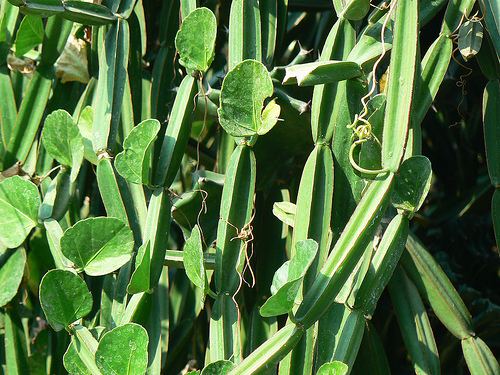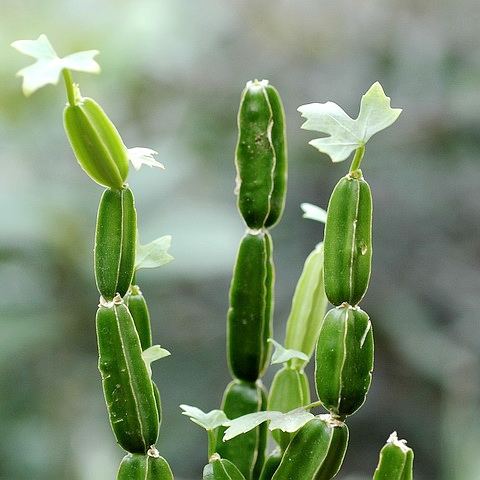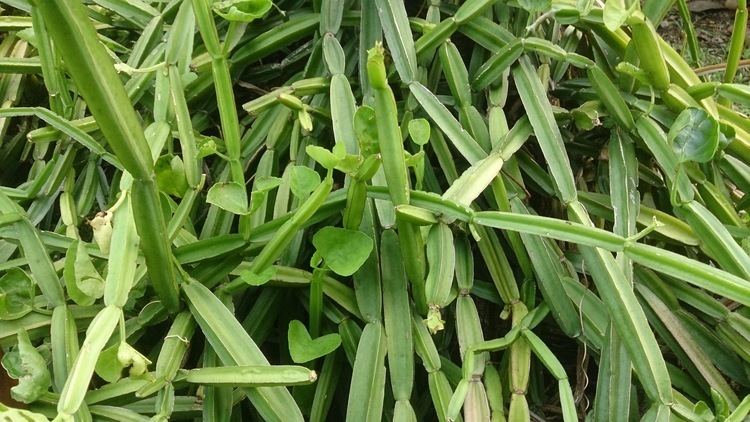Family Vitaceae Rank Species | Order Vitales Genus Cissus Higher classification Treebine | |
 | ||
Similar Treebine, Vitaceae, Green chiretta, Heart‑leaved moonseed, Irvingia | ||
Cissus quadrangularis is a perennial plant of the grape family. It is also known as veldt grape, devil's backbone, adamant creeper, asthisamharaka, hadjod and pirandai.
Contents
- Hadjod plant cissus quadrangularis
- Distribution
- Description
- Traditional medicine
- Experimental studies
- Chemistry
- References

Hadjod plant cissus quadrangularis
Distribution

It is probably native to Bangladesh, India or Sri Lanka, but is also found in Africa, Arabia, and Southeast Asia. It has been imported to Brazil and the southern United States.
Description

Cissus quadrangularis reaches a height of 1.5 m and has quadrangular-sectioned branches with internodes 8 to 10 cm long and 1.2 to 1.5 cm wide. Along each angle is a leathery edge. Toothed trilobe leaves 2 to 5 cm wide appear at the nodes. Each has a tendril emerging from the opposite side of the node. Racemes of small white, yellowish, or greenish flowers; globular berries are red when ripe.
Traditional medicine

Cissus quadrangularis has been used as a medicinal plant since antiquity. Cissus has been used in various Ayurvedic classical medicines to heal broken bones and injured ligaments and tendons. In siddha medicine it is considered a tonic and analgesic, and is believed to help heal broken bones, thus its name asthisamharaka (that which prevents the destruction of bones). The Garo tribe of Bangladesh have used C. quadrangularis as a medicinal plant for bone fracture.
Experimental studies
One preliminary clinical study found a benefit in weight reduction and an improvement in the symptoms associated with metabolic syndrome in obese patients who had been given C. quadrangularis supplements. Another study found a potential synergistic effect between C. quadrangularis and Irvingia gabonensis. A weight loss supplement containing Cissus quadrangularis and other ingredients including green tea, soy, selenium, chromium, and B vitamins was evaluated in an 8-week trial. The supplement helped reduce body weight by 4–8% (placebo 2.4%) a clinically significant weight loss.
A paper published in the World Journal of Gastroenterology in October 2010, on conflicts of interest in alternative weight loss product research, noted that at least three studies supported the safety and effectiveness of CQ for weight loss, but "lack financial disclosures or funding sources, beyond mentioning that the CQ being tested was provided by" General Health Alliances, an herbal products manufacturer. The studies did not disclose that one of its authors was a chief scientific officer for GHA that holds a patent on a CQ product.
C. quadrangularis has been studied for its effects in a rat model for osteoporosis.
C. quadrangularis has been studied in animal models of bone fracture.
Its bactericidal effects on Helicobacter pylori indicate a potential use for treating gastric ulcers in conjunction with NSAID therapy.
Chemistry
C. quadrangularis has been found to contain carotenoids, triterpenoids, and ascorbic acid. The plant also produces the resveratrol dimer quadrangularin A.
